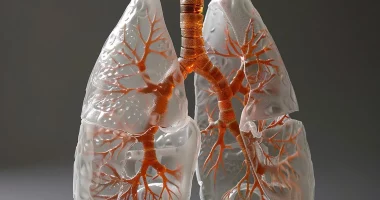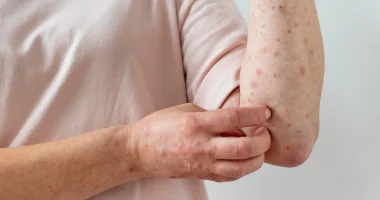An arrhythmia is when your heart beats in an irregular way. It might feel like your heart is fluttering or racing. Usually, it’s not a big problem, but sometimes it can mean your heart has a serious issue that could be deadly.
Your heart beats because of tiny electrical signals. When these signals don’t work right, it causes arrhythmias. This means your heart might beat too fast, too slow, or in a weird pattern. When your heart beats normally, it’s called a “normal sinus rhythm.”
If your heart beats are very irregular or if your heart is damaged or weak, arrhythmias can be dangerous. They can cause serious complications and symptoms, and even be fatal.
Types and Causes
AFib
AFib, or atrial fibrillation, is when the upper chambers of the heart beat irregularly and often fast. It’s common in older adults and can lead to a rapid heartbeat because instead of contracting strongly, the chamber quivers or fibrillates.
Atrial flutter
Atrial flutter is similar but usually starts from one area in the atrium not working properly. Without treatment, it can progress to fibrillation.
Supraventricular tachycardia
SVT, or supraventricular tachycardia, is a fast heartbeat that starts in the upper chambers. It doesn’t allow the heart to fill fully between contractions. Atrial fibrillation and flutter fall under this category.
Ventricular tachycardia
VT, or ventricular tachycardia, happens when abnormal electrical signals begin in the lower chambers, leading to a fast heartbeat. It can be caused by scarring from a before heart attack.
Ventricular fibrillation
VFib, or ventricular fibrillation, is a dangerous irregular rhythm where the lower chambers don’t pump blood but tremble instead. It’s linked to heart disease and can be triggered by a heart attack.
Bradycardia
It is when the heart beats slower than normal, often below 60 bpm. It’s usually due to problems with the heart’s natural pacemaker or other factors like heart disorder, genetics, chest trauma, certain drugs, or hypothermia.
Long QT syndrome
Long QT syndrome is a heart rhythm disorder some people are born with. It can lead to rapid, lacking coordination heartbeats and can be life-threatening due to QT prolongation. It can also be caused by genetics or certain treatments.
Risk Factors
Arrhythmias can be influenced by various risk factors, and the likelihood of developing them may differ depending on the type of arrhythmia.
For instance, aging is often associated with a higher risk of arrhythmias, particularly in older adults. Additionally, a family medical history of arrhythmia can increase the chances of developing one.
Certain lifestyle habits, such as smoking and excessive alcohol consumption, can also contribute to the risk of arrhythmias. Moreover, the use of specific recreational drugs like cocaine or amphetamines may heighten the risk.
Various medical conditions can also be linked to arrhythmias. These include diabetes, obesity, lung disease, kidney disease, and sleep apnea. Furthermore, certain medications, including antibiotics and over-the-counter cold and allergy medications, may increase the likelihood of experiencing arrhythmias.
Understanding these risk factors can help individuals take proactive measures to minimize their risk of developing arrhythmias and maintain heart health.
Symptoms
Arrhythmias can sometimes be tricky to detect because they don’t always show obvious symptoms. Sometimes, a doctor might discover an arrhythmia during a regular check-up even if the person hasn’t noticed anything unusual.
It’s important to note that having symptoms doesn’t always mean the arrhythmia is dangerous. Some people can have serious arrhythmias without any noticeable symptoms, while others might experience symptoms without having a serious arrhythmia.
The symptoms of an arrhythmia can vary depending on the type. For instance, tachycardia, which is a fast heartbeat, can cause breathing problem, fatigue, feeling like you might faint, heart palpitations, chest pain, lightheadedness, or weakness.
On the other hand, bradycardia, which is when the heart beats too slowly, can lead to symptoms like angina, difficulty concentrating, trouble exercising, dizziness, confusion, fatigue, unsteadiness, palpitations, shortness of breath, fainting, or excessive sweating.
For atrial fibrillation (AFib), symptoms can come on suddenly and may include angina, dizziness, breathlessness, heart palpitations, fainting or feeling like you might faint, weakness, or fatigue.
Diagnosis
To diagnose an arrhythmia, healthcare providers first require to identify the irregular heartbeat and determine its source. The process typically begins with the healthcare provider asking about signs and conducting a physical examination. During this exam, they will measure the pulse, heart rate, and blood pressure, listen for any heart murmurs, and examine for symptoms like swelling that might indicate fluid retention.
Following the initial assessment, healthcare providers may recommend several diagnostic tests to gather more information. These tests can include:
- Blood and urine tests: These help check for underlying conditions or substances that might be causing the arrhythmia.
- Electrocardiogram (ECG or EKG): This test records the electrical activity of the heart and can reveal abnormal rhythms.
- Holter monitor: This portable device is worn for 24-48 hours to continuously record the heart’s activity, providing a longer-term view of the heart’s rhythm.
- Electrophysiology study: This involves threading catheters into the heart to measure its electrical activity directly, helping pinpoint the source of the arrhythmia.
- Tilt table test: This test can help determine if changes in posture are causing sudden drops in heart rate or blood pressure, contributing to symptoms.
- Genetic testing: It may be recommended to identify inherited conditions that could be causing the arrhythmia in some cases.
- Heart imaging tests: CT scans or MRIs can provide detailed images of the heart’s structure and function, helping to identify any physical abnormalities that might be causing the arrhythmia.
By combining information from these tests, healthcare providers can accurately diagnose the type of arrhythmia and develop an appropriate treatment plan.
Treatment
Treatment for arrhythmias varies depending on the type and severity of the condition. In some cases, a healthcare provider may simply observe the heart rhythm without recommending any immediate treatment. Treatment becomes necessary if the person has a primary condition, has a chance of complications, or experiences severe signs.
For tachycardia, there are a few treatment options. The choice of treatment rely on the specific type and cause of the tachycardia. These treatments may include carotid sinus massage, where a healthcare professional gently applies pressure to a specific area of the neck, or the Valsalva maneuver, which involves trying to exhale forcefully with a closed mouth and nose. Other options include cardioversion is a process in that restores heart rhythm by using electric shocks, and the implantation of a cardioverter-defibrillator. Cardiac ablation surgery may also be used to destroy small areas of heart tissue that are causing abnormal electrical signals. Treatments to decrease the frequency of episodes or to help regulate the heart’s electrical conduction may also be prescribed.
For bradycardia, treatment options may include intravenous atropine if tests indicate unstable blood pressure, and warming the person if hypothermia is the cause. Addressing any basic heart problems or other conditions is essential, and some patients may require the implantation of a pacemaker to regulate their heartbeat.
When it comes to atrial fibrillation (AFib), treatment can involve several approaches. Lifestyle changes are often recommended, such as increasing physical activity, following a healthy diet, ceasing smoking, avoiding alcohol, healthy maintenance, and stress management. Medications like beta-blockers, calcium channel blockers, or blood thinners may be prescribed to control the heart rate or prevent blood clots. Procedures like electrical cardioversion or the installation of a pacemaker may be necessary. In more severe cases, heart surgery like catheter ablation to destroy abnormal heart tissue or surgical procedures to close off certain parts of the heart, may be required.
Prevention
While it is not always possible to stop arrhythmia, there are steps people can take to decrease their risk. One of the most important steps is to seek help for any underlying medical conditions and follow the prescribed treatment plan. Managing these conditions effectively can significantly lower the risk of developing arrhythmia.
Physical activity or regular exercise is also beneficial. Maintaining an active lifestyle helps keep the heart healthy and can prevent many heart-related issues, including arrhythmia.
Avoiding tobacco and recreational drugs is crucial, as these substances can contribute to heart rhythm problems. Restricting alcohol consumption can also reduce the risk, as excessive drinking is known to affect the heart’s rhythm.
Finally, it is important to check with a doctor before using any new supplements or medication. Some substances can interfere with heart function or interact negatively with existing treatments, potentially leading to arrhythmias.
By following these guidelines, individuals can take proactive steps to lower their risk of arrhythmia and promote overall heart health.
Summary
Arrhythmia is when your heart doesn’t beat the way it should.
Many things can cause arrhythmia, but it’s often linked to heart disease. Certain medications can also cause it. Sometimes, arrhythmia can signal a serious health issue and might lead to serious problems. That’s why it’s important to see a doctor if you notice any signs of arrhythmia.
You can’t always stop arrhythmias, but there are ways to lower your risk. Regular exercise, keeping a healthy weight, and treating any existing health problems can help reduce the chances of developing arrhythmia.









